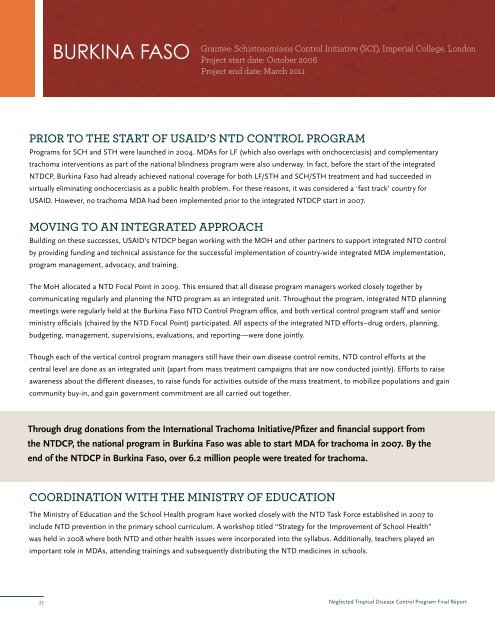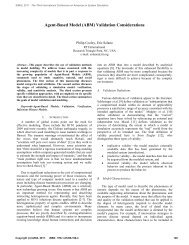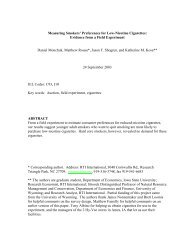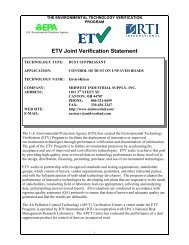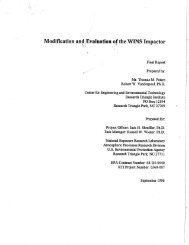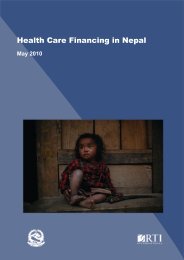Neglected tropical disease coNtrol program - RTI International
Neglected tropical disease coNtrol program - RTI International
Neglected tropical disease coNtrol program - RTI International
You also want an ePaper? Increase the reach of your titles
YUMPU automatically turns print PDFs into web optimized ePapers that Google loves.
BURKINA FASOGrantee: Schistosomiasis Control Initiative (SCI), Imperial College, LondonProject start date: October 2006Project end date: March 2011Prior to the Start of USAID’s NTD Control ProgramPrograms for SCH and STH were launched in 2004. MDAs for LF (which also overlaps with onchocerciasis) and complementarytrachoma interventions as part of the national blindness <strong>program</strong> were also underway. In fact, before the start of the integratedNTDCP, Burkina Faso had already achieved national coverage for both LF/STH and SCH/STH treatment and had succeeded invirtually eliminating onchocerciasis as a public health problem. For these reasons, it was considered a ‘fast track’ country forUSAID. However, no trachoma MDA had been implemented prior to the integrated NTDCP start in 2007.Moving to an Integrated ApproachBuilding on these successes, USAID’s NTDCP began working with the MOH and other partners to support integrated NTD controlby providing funding and technical assistance for the successful implementation of country-wide integrated MDA implementation,<strong>program</strong> management, advocacy, and training.The MoH allocated a NTD Focal Point in 2009. This ensured that all <strong>disease</strong> <strong>program</strong> managers worked closely together bycommunicating regularly and planning the NTD <strong>program</strong> as an integrated unit. Throughout the <strong>program</strong>, integrated NTD planningmeetings were regularly held at the Burkina Faso NTD Control Program office, and both vertical control <strong>program</strong> staff and seniorministry officials (chaired by the NTD Focal Point) participated. All aspects of the integrated NTD efforts–drug orders, planning,budgeting, management, supervisions, evaluations, and reporting—were done jointly.Though each of the vertical control <strong>program</strong> managers still have their own <strong>disease</strong> control remits, NTD control efforts at thecentral level are done as an integrated unit (apart from mass treatment campaigns that are now conducted jointly). Efforts to raiseawareness about the different <strong>disease</strong>s, to raise funds for activities outside of the mass treatment, to mobilize populations and gaincommunity buy-in, and gain government commitment are all carried out together.Through drug donations from the <strong>International</strong> Trachoma Initiative/Pfizer and financial support fromthe NTDCP, the national <strong>program</strong> in Burkina Faso was able to start MDA for trachoma in 2007. By theend of the NTDCP in Burkina Faso, over 6.2 million people were treated for trachoma.Coordination with the Ministry of EducationThe Ministry of Education and the School Health <strong>program</strong> have worked closely with the NTD Task Force established in 2007 toinclude NTD prevention in the primary school curriculum. A workshop titled “Strategy for the Improvement of School Health”was held in 2008 where both NTD and other health issues were incorporated into the syllabus. Additionally, teachers played animportant role in MDAs, attending trainings and subsequently distributing the NTD medicines in schools.35<strong>Neglected</strong> Tropical Disease Control Program Final Report


